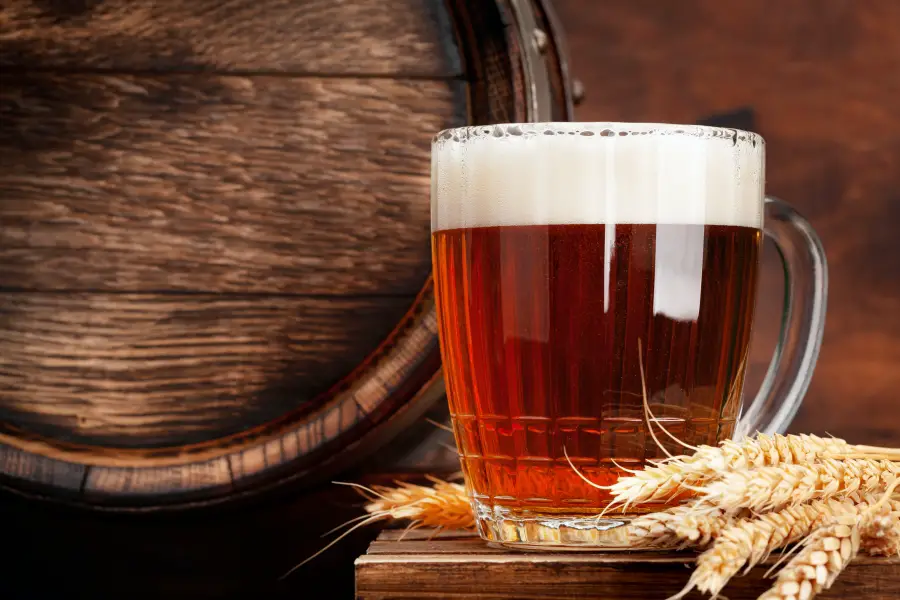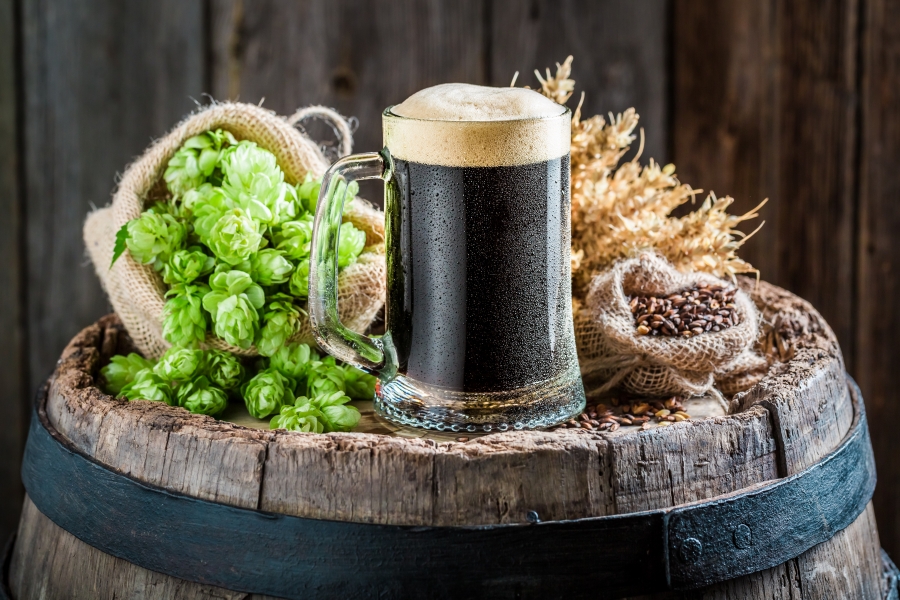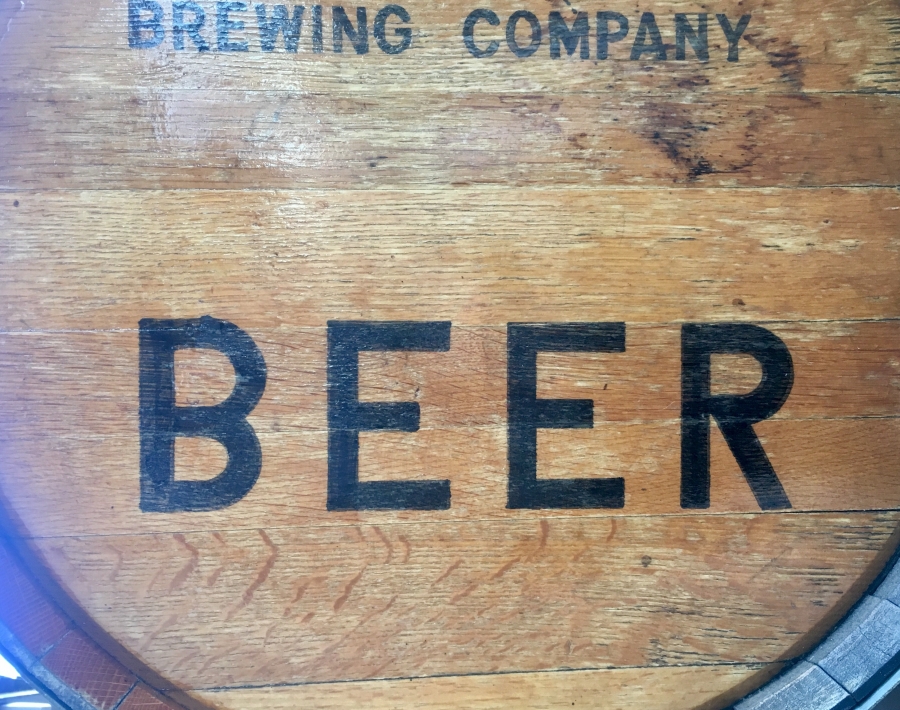The influence of the barrel on the taste of wine is recognised all over the world, and wines aged in oak barrels - barriques - are prized and expensive. But less is said about the influence of casks on beer. It's not about industrially produced beer, where the containers are made of stainless steel and fibreglass, but craft beer, which has been making a strong comeback since the 1990s. This trend can be seen here, where it is no longer a problem to find beer with different flavours, aged or with a high alcohol content. Many of these processes of enriching beer with special flavours involve wooden barrel impregnated with various flavours.

Beer, the drink from which the expression comeshoneymoon
Not surprisingly, brewers think of the wooden barrel when they want to add special flavours to their beer. Wooden vessels have been used for 2000 years for fermenting, storing and transporting beer. But beer is much older. The earliest evidence of beer brewing dates back more than 6000 years to the Sumerians and Babylonians. In The Epic of Ghilgames, wildlife Enkidu drink milk and beer, just like humans. The Sumerians' custom of giving young couples beer sweetened with honey is also related to the honeymoon celebrated nowadays by newlyweds. But in those days beer was kept in animal skin containers or ceramic pots.
The Egyptians originally got their beer from the Babylonians, then started brewing it themselves. It was considered a special drink and was therefore given as an offering to the gods and used in traditional medicine. The first tax on the drink is also linked to Egypt. Cleopatra, in order to raise the money needed to build a pyramid dedicated to her, imposed a tax on beer consumption. The Romans also used it as a cure, with beer-based recipes for coughs and bee stings dating back to that time. The shift from ceramic vessels to wooden barrels took place during the Roman Empire, with the Gauls imposing the new method of storage and transport. The Germanic peoples took over beer recipes from the Romans and obtained different tastes depending on the wood of the barrels in which they fermented the beer.
After the break-up of the Roman Empire many lands were taken over by monasteries. Brewing beer from various natural ingredients began here. Beer was considered a very nutritious food and was widely consumed during the fasting period. Beers were sometimes named after saints and because they could not explain why the taste was sometimes good and sometimes bad, fermentation was linked to the presence of spirits and witches. These supposed witches who spoiled the taste of beer could even be burned at the stake. The last such event dates back to the 16th century.
In modern times brewing has been easier to control and replicate which has led to brewing on an ever larger scale. The advent of materials that don't affect taste - glass and later stainless steel and fibreglass - led to a gradual move away from wooden kegs for fermentation, storage and transport. Industrially produced beer was stable, reproducible in taste and affordable for everyone. But it had lost much of its personality, which led to the resurgence of craft brewing in the 1980s and 1990s. From there, the phenomenon took off, with craft beers with distinctive tastes and flavours now found everywhere.

Fermentation versus aging of beer in oak barrels
The main beer-producing countries are in the northern part of the European continent. Beer has caught on mainly in countries that were not very conducive to growing vines because of lower temperatures and shorter sunny periods. The first to use wood to modify the taste of beer were the Germans. Discovering that beer tasted different depending on the species used to make the cask, they tried to achieve new tastes by juggling these species. The most important influence, however, was the oak. Even today, the oak cask is where traditional beer is fermented.
Although in many cases the barrel has been replaced by stainless steel pots, there have been brewers who have remained faithful to traditional brewing. True, stainless steel pots are easier to clean, but they are inert and don't add to the taste of the beer.
Wood is somewhat unpredictable compared to steel, but has the advantage of compounds that contribute to the formation of flavour and porosity, which allow micro-organisms to participate in the process with repercussions on the taste and quality of the beer. The size of the keg is important and the smaller the container, the greater the influence. The origin of the oak is also important, with big differences between casks made from European or American oak.
In the keg, the beer may ferment or be aged. For ferment, the mixture of grain, water and yeast is put directly into the oak barrel. During the process the sugars are converted into alcohol and the oak contributes tannins to the taste lemnos of beer. The whole fermentation process takes place in the cask, which makes the oak wood part of the final taste. The result is a beer with a more pronounced bitter taste, dense and full-bodied. As with wine ageing, barrel fermentation is sometimes replaced by adding oak chips to the fermentation vessel. This reduces costs.
Ageing in kegs is the operation that is done after the beer has fermented. In this case, casks in which other alcoholic beverages have been aged are used: whisky, bourbon, rum, gin, tequila, wine. Brewers know where they want to end up and choose the barrel according to the desired end result.

Flavours of beer from kegs used for other drinks
In general, ageing beers have an alcohol content higher than 8%. During ageing the colour darkens, the beer becomes fuller-bodied, with a more balanced, rounder taste. Both whiteand dark ones. Depending on the cask used, the beer may taste vanilla, caramel, nutty, dill, smoky, slightly sour, etc. The density, bitterness and colour, however, depend on the base.
Bourbon barrels are a common choice for imparting caramel and vanilla flavours to beer. Single malt whiskey butts add a smoky note. Wine barrels give a more sour taste to the beer and add notes of cherry, blackberry or raisin. The tannins in the red wine steeped in the cask give the taste an astringent note. The time the beer spends in the cask is also important. A short ageing takes away more of the taste of the drink that has been in the cask. A longer time will allow the beer to get to the burnt wood part of the barrel and extract notes of vanilla, coconut, cinnamon, anise, chocolate, coffee.
Brewers are also experimenting to better understand the role of the keg in adding flavours. For example, the same type of beer imperial ale (richer in alcohol and flavors) was aged the same time in bourbon, rum, fresh red wine, port and sherry casks. From the bourbon it picked up flavours of coconut, dill and sweet spices, from the rum - oak and dark chocolate, from the fresh wine - sour and wild notes, from the port wine - notes of cherries in chocolate, and from the Sherry wine - grape skins and oak.

Romanian craft beer
In Romania, too, many kinds of craft beers are produced, each with a more or less interesting taste. A Belgian-inspired beer that was also appreciated by the Belgian ambassador in Bucharest was made by the Oriel craft brewery. The beer was fermented for a month in a stainless steel pot, then transferred to a Jack Daniels barrel where it was kept for 6 months. The beer was then bottled and left to re-ferment for 21 days, then chilled for another 21 days. After eight and a half months, the beer was presented at an event attended by the Belgian ambassador. Find the full story here.
Tasting craft beers is as exciting as tasting wines, and those aged in various barrels are truly special. If you have such an opportunity, don't miss it.
I hope you find the above information interesting. As usual, additions are welcome. And if you have any questions or queries, please leave them in the space below. I will certainly answer



























Add comment